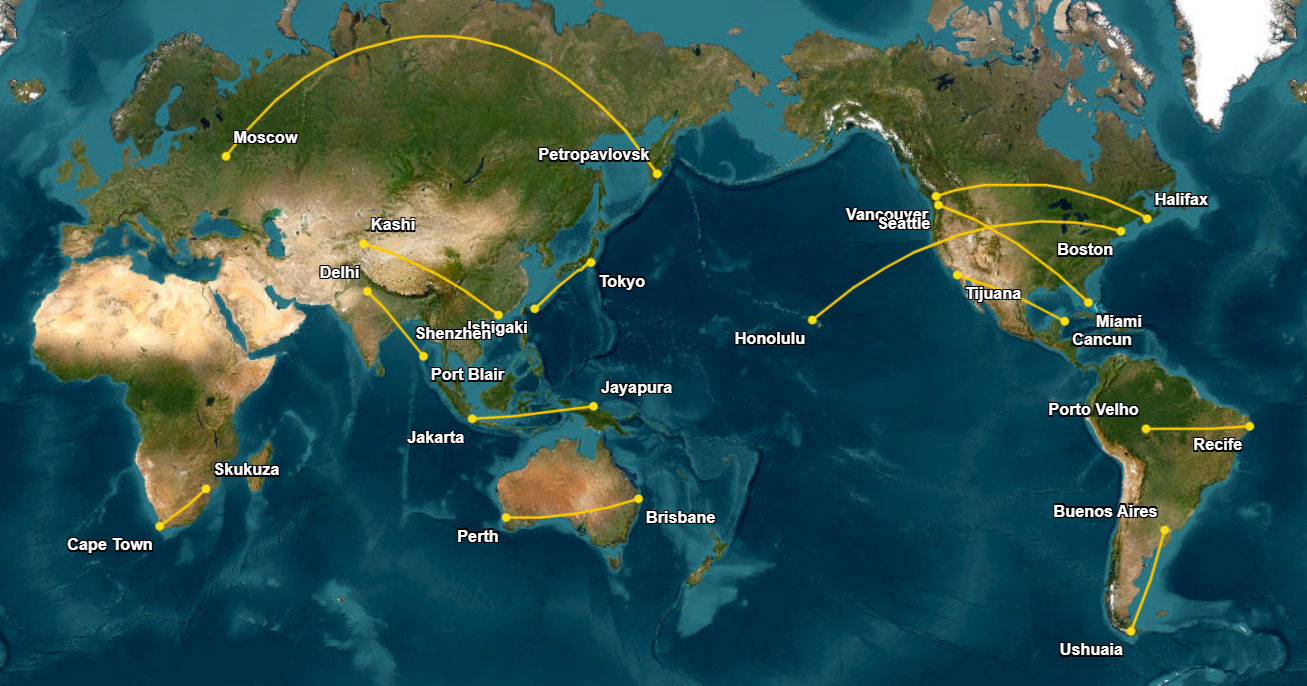Longest Domestic Flights Map


Marcus Rodriguez
Historical Geography Expert
Marcus Rodriguez specializes in historical cartography and geographic data analysis. With a background in both history and geography, he brings unique...
Geographic Analysis
What This Map Shows\nThis map illustrates the longest domestic flights from selected countries, providing a unique perspective on the vast distances that travelers must cover within their own nations. From the snowy expanses of Russia to the tropical landscapes of Brazil, the distances involved in domestic air travel can be surprisingly extensive. The visualization highlights the flight durations between major cities, showcasing how geography influences travel within countries.
Deep Dive into Domestic Air Travel Distances\nDomestic flights are a vital part of the transportation infrastructure in many countries, connecting diverse regions and facilitating commerce, tourism, and cultural exchange. Interestingly, the longest domestic flights often span across varied terrains, including mountains, forests, and coastlines. For instance, the flight from Boston to Honolulu takes approximately 11 hours and 15 minutes, covering a staggering distance that traverses multiple time zones and climatic zones. This flight is a prime example of how geography can dramatically affect travel time.
In Russia, the flight from Moscow to Petropavlovsk on the Kamchatka Peninsula lasts about 8 hours and 40 minutes. This journey highlights the vastness of the country, where travel often requires crossing expansive Siberian landscapes, which are not only remote but also sparsely populated. The geographical challenges of such flights often include weather variations and limited infrastructure in certain regions.
In Canada, the flight from Halifax to Vancouver takes approximately 6 hours and 20 minutes. Covering a distance of over 2,500 miles, this route showcases the country’s diverse geography, from the Atlantic coastline of Nova Scotia to the mountainous terrains of British Columbia. The contrast in climate and landscape between these two cities is stark, with Halifax experiencing a maritime climate and Vancouver enjoying a milder, temperate climate due to its coastal position.
Other notable long domestic flights include Kashi to Shenzen in China (6 hours and 10 minutes) and Jakarta to Jayapura in Indonesia (5 hours and 20 minutes). Both flights traverse vast and varied terrains, from the deserts of Xinjiang in China to the lush rainforests of Papua. These journeys are not just about the distance; they also reflect the geographical and cultural diversity of the regions they connect.
Regional Analysis\nWhen we break down the longest domestic flights by region, interesting patterns emerge. In North America, flights tend to be longer due to the sheer size of the countries involved. For example, the Miami to Seattle flight lasts 6 hours and 40 minutes, highlighting the length of the United States from coast to coast. In contrast, flights within smaller countries, like the Tijuana to Cancun route in Mexico (4 hours and 20 minutes), are relatively shorter but still crucial for connecting different parts of the nation.
In South America, the flight from Buenos Aires to Ushuaia (3 hours and 40 minutes) is fascinating not just for its duration but also for the unique geography of Ushuaia, which is known as the southernmost city in the world. This flight traverses the scenic landscapes of Patagonia, showcasing the stunning natural beauty of the region. Similarly, in Africa, the Cape Town to Skukuza flight (2 hours and 25 minutes) links urban life with the wilderness of Kruger National Park, emphasizing how geography affects tourism and conservation efforts.
In Asia, the domestic flights also reflect the geographical diversity of the continent. The journey from Delhi to Port Blair (3 hours and 40 minutes) connects the bustling capital with the serene Andaman Islands, illustrating how geography can influence cultural exchange and tourism opportunities.
Significance and Impact\nUnderstanding the significance of long domestic flights goes beyond mere distances; it encompasses the economic, social, and environmental implications of air travel. As globalization continues to expand, the demand for air travel is likely to increase, which raises questions about sustainability and the environmental impact of aviation.
Interestingly, as countries modernize and expand their transportation networks, the distances of domestic flights may change. Future advancements in aircraft technology could lead to shorter travel times, making remote regions more accessible. This evolution could foster greater economic opportunities in less populated areas, ultimately reshaping national demographics and economic landscapes.
Furthermore, with the rise of remote work and digital nomadism, the patterns of domestic travel may shift. More people might opt for longer vacations that cover vast distances within their own countries, affecting tourism industries and local economies. As we move forward, understanding these flight patterns will be crucial for addressing environmental concerns and enhancing connectivity across vast countries.
In conclusion, the map of the longest domestic flights not only showcases the incredible distances travelers must navigate but also serves as a lens through which we can examine the interconnectedness of geography, culture, and economics across the globe.
Visualization Details
- Published
- October 4, 2025
- Views
- 54
Comments
Loading comments...